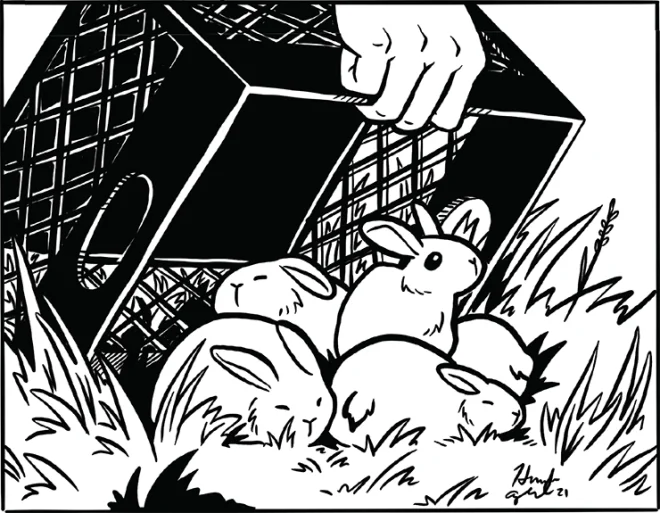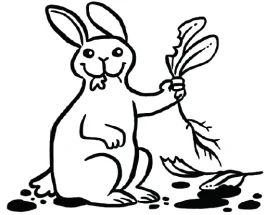
One morning in early August, I noticed what looked like a long divot in the turf of our side yard. Since the lawn-mowing crew in our New Jersey development hadn’t been at work for several days, this new gouge seemed odd. So later that day, I went out intending to repair the displaced turf.
What I found was quite surprising. Under the tuft of grass was a bowl-shaped hollow about the size of a softball. This was not a skid mark but a nest awaiting little occupants. I carefully replaced the tuft and went back inside to await developments. It wasn’t a long wait.
That evening my wife noticed a rabbit sitting by the nest. We watched her for a while but respected her privacy. The following afternoon, I carefully lifted the grass, and there they were: six kits, baby bunnies bunched together in a ball of gray fur. I could count them only by their pairs of little ears. Again, wanting to minimize disturbance, I gently replaced the grass and went back inside to announce their arrival to my wife.
Now, of course, rabbits are vegetarians. They like to eat the tender shoots and flowers that gardeners devote so much time and care nurturing. We can all remember the story of Peter Rabbit and his encounter with farmer MacGregor and his ominous rake. Like MacGregor, my wife is a gardener, which explained her reaction to my news that there were now a half-dozen hungry little bunnies sheltering in our side yard. I think the Latin term for her reaction would be leprocidal. Fortunately for these bunnies, our rake was in the garage and safely out of easy reach.
“But they are little bunnies!” I pleaded. “They’re so cute.”
Figuring that my plea would be bolstered by the sight of the kits themselves, I took her out and showed her how cute the little bunnies actually were. I think it was the dozen precious little ears that turned the trick and softened the heart of my beloved gardener. There would be no leprocide in the side yard this August.
Of course, there were other threats to our bunnies: crows, hawks, and owls. However, the weekly lawnmower crew posed a more immediate hazard. When I heard them moving through the neighborhood, I went out and placed a plastic milk crate over the nest and one of those little “Do Now Mow” flags atop the crate. I hoped this might suffice, but I was still concerned.
It so happened that my brother-in-law was visiting from Colorado. Knowing that he was fairly fluent in Spanish, I asked him the Spanish word for “rabbit” so I could explain the milk crate to the Latino mower jockey. As the mower entered the yard, I went out and waved the driver to a halt. The following dialogue ensued.
Me: “English or Espanol?”
Driver (smiling): “Espanol.”
Me (pointing at the milk crate): “Conejo.”
At this point the smile became a chuckle, but I couldn’t tell whether this was because of my peculiar Spanish pronunciation or a misunderstanding of the reference: the milk crate obviously was not a conejo. I lifted the crate and resorted to sign language.
Me (with hands by the sides of my head feigning rabbit ears): “Conejo, conejo!”
Fortunately for my dignity, the fellow intuited my meaning without me having to go into a version of the bunny hop. He was now laughing, along with two other mower men who’d stopped to watch this ridiculous charade.
Assured that we all understood about protecting the conejo, I replaced the milk crate and retired to my kitchen to watch. They finished mowing, carefully avoiding my homemade bunny sanctuary.
Days passed and the sheltering tuft of grass swelled to a mound as the kits grew into recognizable bunnies and wriggled for space in the crowded nest. Then late one afternoon I saw the mother rabbit sitting by the nest as her six little ones hopped around her on the twilight lawn. She retreated to the shelter of our neighbor’s foundation and, with her back to the wall, began to nurse a couple of the little ones by turns. After a while she led her family under the boughs of a towering spruce that shelters local squirrels, chipmunks, and rabbits. When I went out the next morning to check on the nest, I found it was empty; all six of the little bunnies had made it safely through infancy. They were now on their own to nibble through the environs—and gardens—of our neighborhood.

I wish them luck evading the local Mr. MacGregors and their rakes. My own beloved gardener has other wishes for them. As she ruefully reminds me, bunnies may be cute, but rabbits?
Rabbits are pests. ❖


 Previous
Previous

